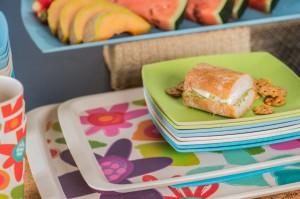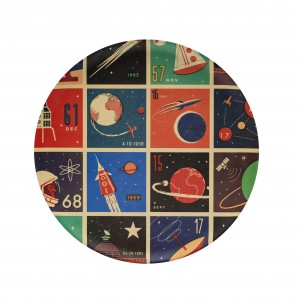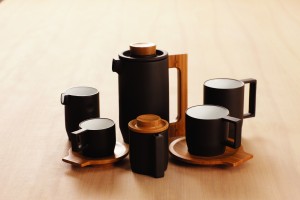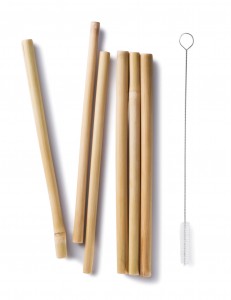Getting Creative with Bamboo
By Amber Gallegos
Kitchenware brands are modernizing the way bamboo is interpreted, using it to convey anything but Old World quaint. Bamboo is a decidedly not-new material, but the woody grass traditionally used for cutting boards and cooking spoons is seeing new life through creative uses, like bamboo fiber. With a contemporary approach to product design, bamboo is sprouting up in some unexpected forms.
The use of bamboo fiber allows the highly renewable material to act essentially as a plastic substitute with the added benefit that it is biodegradable. One of the fastest-growing plants on Earth, bamboo takes only about three to five years to reach maturity and be harvested. In comparison, an oak tree will take at least 60 years to reach maturity, and pine trees need around 25 years to be ready for harvest. Bamboo self-regenerates from its root system once it is harvested, which is another sustainability point in its favor.
Long known for its classic stoneware and porcelain serving accessories, bakeware and dinnerware, 63-year-old BIA Cordon Bleu turned to bamboo fiber when the company sought a new material to add to its assortment. “For us it’s just sort of a way of branching out a little bit more into other materials,” says Paul Baughman, BIA Cordon Bleu President. “It’s a matter of we wanted to have something a little younger and hipper. We have customers asking for things that are a little more eco-friendly, perhaps.”
 BIAmboo products are made from a mixture of about 80 percent bamboo fiber, 15 percent corn starch and 5 percent resin to hold it all together, says Baughman. The components are mixed into a liquid slurry that is then extruded, put into molds, high-pressure pressed, and finished with a slight heat process that gels it all together. The result is a product that is lightweight with a matte finish and a slight tactile texture. It is also free of chemicals, food-safe and top rack dishwasher-safe, although not microwave-safe due to the resins. Once it is buried in the ground, the product is completely biodegradable on a long enough timeline.
BIAmboo products are made from a mixture of about 80 percent bamboo fiber, 15 percent corn starch and 5 percent resin to hold it all together, says Baughman. The components are mixed into a liquid slurry that is then extruded, put into molds, high-pressure pressed, and finished with a slight heat process that gels it all together. The result is a product that is lightweight with a matte finish and a slight tactile texture. It is also free of chemicals, food-safe and top rack dishwasher-safe, although not microwave-safe due to the resins. Once it is buried in the ground, the product is completely biodegradable on a long enough timeline.
Baughman described the line as semi-disposable, but a product that will still last for years. Under testing through a commercial dishwasher, BIAmboo pieces only began to lose some color after about 200 washes. The durability of the line, ability to go indoors or outdoors and eco-friendly appeal, will make it a nice option for many retailers, Baughman says.
“I think there’s always this test where retailer are trying to figure out what the Millennial is looking for, what are they all about, and they are perhaps a little more eco-friendly then when we grew up,” says Baughman “It’s for somebody who’s looking for a slightly different material. A little bit younger bent, but they want to fulfill something that maybe Millennials are looking for.”
Suggested retail prices for BIAmboo range from $5 to $25, with over 35 SKUs available.
 In the U.K., Jay is another brand utilizing bamboo fiber for its platters, trays and coasters. Both the Cosmos and Anatomical collections from Jay feature bamboo fiber items. Bamboo Fiber Cosmos Catch-All Trays from Jay play on a space exploration theme and are designed with a vintage feeling. The set of four square 5.5-inch diameter trays have rounded corners and each feature a different scene, one has a meteorite shooting through space, while another shows a rocket blasting off. The Cosmos Large Platter incorporates these scenes and more on a grid that spans the platter’s 12.79-inch diameter. Cosmos Catch-All Trays have a suggested retail price of $18 for a set of four, and the Cosmos Large Platter retails for $24.
In the U.K., Jay is another brand utilizing bamboo fiber for its platters, trays and coasters. Both the Cosmos and Anatomical collections from Jay feature bamboo fiber items. Bamboo Fiber Cosmos Catch-All Trays from Jay play on a space exploration theme and are designed with a vintage feeling. The set of four square 5.5-inch diameter trays have rounded corners and each feature a different scene, one has a meteorite shooting through space, while another shows a rocket blasting off. The Cosmos Large Platter incorporates these scenes and more on a grid that spans the platter’s 12.79-inch diameter. Cosmos Catch-All Trays have a suggested retail price of $18 for a set of four, and the Cosmos Large Platter retails for $24.
“Overall, people are becoming much more aware of the need to be replacing other more toxic materials and processes with environmentally-friendly alternatives,” says Cronin. “Then you have that group of people that have always been aware and focused on sustainability. They may be people that are also vegetarians and vegans, or just environmentalists. There’s always been that niche of people that have searched high and low for products that are eco-friendly and from sustainable materials, but I think the appeal is becoming much wider as the general public are becoming more informed.”
 JIA Inc. products are based on Chinese culture and aim to re-interpret traditional Chinese materials and craftsmanship through modern design. This can be seen in pieces like the Family Bowls and Lotus Leaf Plates that combine the quintessentially Chinese materials, porcelain and bamboo. The handmade bowls have a bamboo exterior comprised of bamboo strips with a white or black porcelain interior. The plates sandwich bamboo between two layers of porcelain, resulting in a bamboo rim on the plates. JIA Inc. also incorporates bamboo elements throughout many other of the brand’s collections. The Purple Clay Coffee Set has bamboo lids, handles, and saucers; while the Abundance Multifunction Food Box is porcelain with a silicone sleeve and bamboo lid that can also be used as a trivet or plate. The simple clean lines of the products update the look of bamboo in a contemporary fashion that is also instantly classic.
JIA Inc. products are based on Chinese culture and aim to re-interpret traditional Chinese materials and craftsmanship through modern design. This can be seen in pieces like the Family Bowls and Lotus Leaf Plates that combine the quintessentially Chinese materials, porcelain and bamboo. The handmade bowls have a bamboo exterior comprised of bamboo strips with a white or black porcelain interior. The plates sandwich bamboo between two layers of porcelain, resulting in a bamboo rim on the plates. JIA Inc. also incorporates bamboo elements throughout many other of the brand’s collections. The Purple Clay Coffee Set has bamboo lids, handles, and saucers; while the Abundance Multifunction Food Box is porcelain with a silicone sleeve and bamboo lid that can also be used as a trivet or plate. The simple clean lines of the products update the look of bamboo in a contemporary fashion that is also instantly classic.
 Bambu is a Portland, Oregon based company that makes handcrafted bamboo home products. The serving pieces, cutting boards, bowls, and serving trays combine modern design with this traditional material. The reusable Bamboo Straws are cut from nature and keep the shape of a bamboo stalk. They are hand-selected for the right diameter, then cleaned, sanded and finished with an organic food-safe oil. A set of six straws retails for $8.50 and includes a cleaning brush. The straws recently won an award at NY NOW’s Summer 2015 Eco Choice Awards for Most Innovative.
Bambu is a Portland, Oregon based company that makes handcrafted bamboo home products. The serving pieces, cutting boards, bowls, and serving trays combine modern design with this traditional material. The reusable Bamboo Straws are cut from nature and keep the shape of a bamboo stalk. They are hand-selected for the right diameter, then cleaned, sanded and finished with an organic food-safe oil. A set of six straws retails for $8.50 and includes a cleaning brush. The straws recently won an award at NY NOW’s Summer 2015 Eco Choice Awards for Most Innovative.

You must be logged in to post a comment.